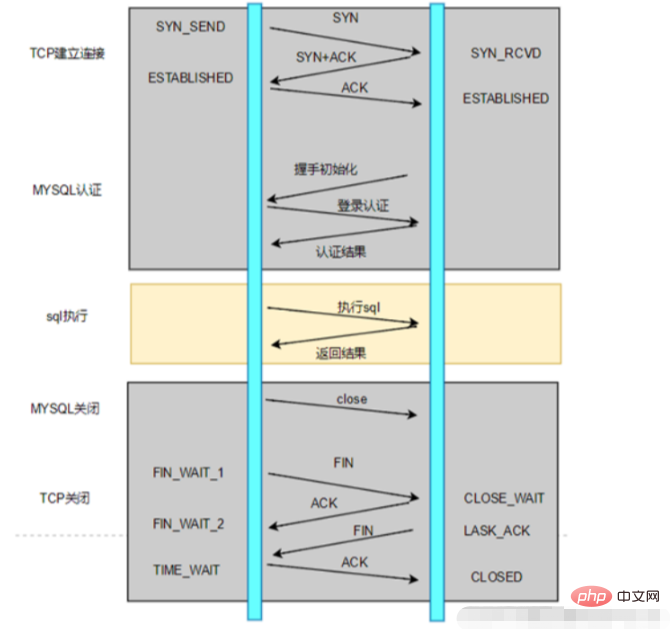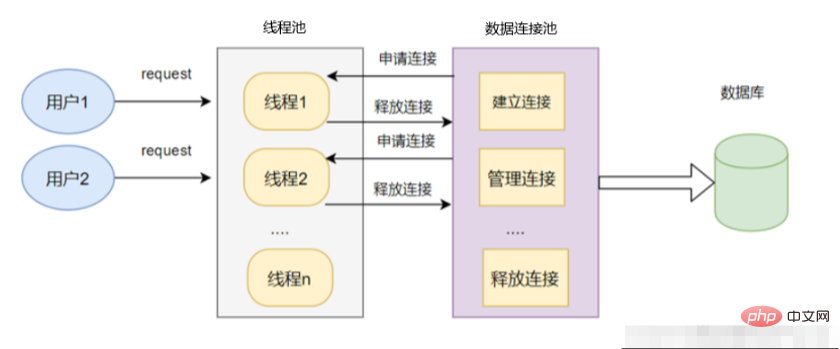What is mysql connection pool
In mysql, the connection pool creates a certain number of database connections when the program starts, and puts these connections into a pool for management; the program dynamically applies for, uses, and releases connections. Reasons for using database connection pool: 1. Resource reuse, which increases the stability of system operation on the basis of reducing system resource consumption; 2. Faster response speed; unified connection management to avoid database connection leakage.

The operating environment of this tutorial: windows7 system, mysql8 version, Dell G3 computer.
1. Pooling technology
The connection pool is the buffer of the connection object, which will store some connections. When the program When you need to use a connection, if it exists in the connection pool, it will be obtained directly from the connection pool without re-creating the connection. Connection pooling allows programs to reuse connections.
Pooling technology can reduce the number of object creations and improve the response performance of the program. Especially in high-concurrency scenarios, the effect is more obvious. When the creation of an object requires a large amount of resources, resulting in a long creation time, you can consider using pooling technology to cache it for subsequent reuse. Common pooling components include: memory pool, thread pool, connection pool, etc.
2. What is a database connection pool?
Definition: The database connection pool creates a certain number of database connections when the program starts. These connections are put into a pool for management. The application, use and release of connections are dynamically performed by the program. Note that the database does not only refer to Mysql, but also a connection pool can be designed for Redis.
3. Why use database connection pool
Resource reuse. Avoiding the performance overhead caused by frequent creation and destruction, reduces system resource consumption, and increases the stability of system operation, mainly reducing memory fragmentation and temporary creation of threads or processes.
Faster response speed. Since several connections are prepared when the program starts, business requests can be used directly. There is no need to perform operations such as connection creation, permission verification, and destruction in real time, thus reducing the system's response time.
Uniform connection management to avoid database connection leakage. The timeout period for connection occupation can be preset. If a certain connection is occupied for more than the set value, the connection can be forcibly recycled.
4. The establishment process of Mysql database connection
The client initiates a connection request, TCP three-way handshake
Mysql internal permission verification
SQL execution statement
Mysql shutdown
Disconnect, TCP waves four times
4.1 No connection pooling
Every time a SQL statement is executed, a connection needs to be established to perform operations such as TCP three-way handshake, permission verification, database operations, database user logout, four waves, etc.

Advantages: Simple implementation, no need to design a connection pool;
Disadvantages: The application frequently creates and destroys temporary connection objects, resulting in a large amount of memory fragmentation. In addition, during the connection A large number of TIME_WAIT states will appear after closing.
4.2 Use connection pool
When the program starts, it creates a number of backup connections, and each time SQL obtains the available connection operations, quack quick.

##5. The operating principle of the connection pool
- From The connection pool obtains a connection or creates a connection;
- Use the connection and return it to the connection pool after use;
- Close all connections before the system is shut down. And release resources
6. Relationship between thread pool and connection pool
 General thread pool The number is consistent with the number of connection pools, and the thread returns the connection after using it.
General thread pool The number is consistent with the number of connection pools, and the thread returns the connection after using it.
- The thread pool actively performs tasks
- The connection pool is used passively. A connection can only be applied for and used by one thread.
mysql video tutorial]
The above is the detailed content of What is mysql connection pool. For more information, please follow other related articles on the PHP Chinese website!

Hot AI Tools

Undresser.AI Undress
AI-powered app for creating realistic nude photos

AI Clothes Remover
Online AI tool for removing clothes from photos.

Undress AI Tool
Undress images for free

Clothoff.io
AI clothes remover

Video Face Swap
Swap faces in any video effortlessly with our completely free AI face swap tool!

Hot Article

Hot Tools

Notepad++7.3.1
Easy-to-use and free code editor

SublimeText3 Chinese version
Chinese version, very easy to use

Zend Studio 13.0.1
Powerful PHP integrated development environment

Dreamweaver CS6
Visual web development tools

SublimeText3 Mac version
God-level code editing software (SublimeText3)

Hot Topics
 MySQL's Role: Databases in Web Applications
Apr 17, 2025 am 12:23 AM
MySQL's Role: Databases in Web Applications
Apr 17, 2025 am 12:23 AM
The main role of MySQL in web applications is to store and manage data. 1.MySQL efficiently processes user information, product catalogs, transaction records and other data. 2. Through SQL query, developers can extract information from the database to generate dynamic content. 3.MySQL works based on the client-server model to ensure acceptable query speed.
 How to start mysql by docker
Apr 15, 2025 pm 12:09 PM
How to start mysql by docker
Apr 15, 2025 pm 12:09 PM
The process of starting MySQL in Docker consists of the following steps: Pull the MySQL image to create and start the container, set the root user password, and map the port verification connection Create the database and the user grants all permissions to the database
 Laravel Introduction Example
Apr 18, 2025 pm 12:45 PM
Laravel Introduction Example
Apr 18, 2025 pm 12:45 PM
Laravel is a PHP framework for easy building of web applications. It provides a range of powerful features including: Installation: Install the Laravel CLI globally with Composer and create applications in the project directory. Routing: Define the relationship between the URL and the handler in routes/web.php. View: Create a view in resources/views to render the application's interface. Database Integration: Provides out-of-the-box integration with databases such as MySQL and uses migration to create and modify tables. Model and Controller: The model represents the database entity and the controller processes HTTP requests.
 Solve database connection problem: a practical case of using minii/db library
Apr 18, 2025 am 07:09 AM
Solve database connection problem: a practical case of using minii/db library
Apr 18, 2025 am 07:09 AM
I encountered a tricky problem when developing a small application: the need to quickly integrate a lightweight database operation library. After trying multiple libraries, I found that they either have too much functionality or are not very compatible. Eventually, I found minii/db, a simplified version based on Yii2 that solved my problem perfectly.
 How to install mysql in centos7
Apr 14, 2025 pm 08:30 PM
How to install mysql in centos7
Apr 14, 2025 pm 08:30 PM
The key to installing MySQL elegantly is to add the official MySQL repository. The specific steps are as follows: Download the MySQL official GPG key to prevent phishing attacks. Add MySQL repository file: rpm -Uvh https://dev.mysql.com/get/mysql80-community-release-el7-3.noarch.rpm Update yum repository cache: yum update installation MySQL: yum install mysql-server startup MySQL service: systemctl start mysqld set up booting
 Centos install mysql
Apr 14, 2025 pm 08:09 PM
Centos install mysql
Apr 14, 2025 pm 08:09 PM
Installing MySQL on CentOS involves the following steps: Adding the appropriate MySQL yum source. Execute the yum install mysql-server command to install the MySQL server. Use the mysql_secure_installation command to make security settings, such as setting the root user password. Customize the MySQL configuration file as needed. Tune MySQL parameters and optimize databases for performance.
 Laravel framework installation method
Apr 18, 2025 pm 12:54 PM
Laravel framework installation method
Apr 18, 2025 pm 12:54 PM
Article summary: This article provides detailed step-by-step instructions to guide readers on how to easily install the Laravel framework. Laravel is a powerful PHP framework that speeds up the development process of web applications. This tutorial covers the installation process from system requirements to configuring databases and setting up routing. By following these steps, readers can quickly and efficiently lay a solid foundation for their Laravel project.
 MySQL vs. Other Programming Languages: A Comparison
Apr 19, 2025 am 12:22 AM
MySQL vs. Other Programming Languages: A Comparison
Apr 19, 2025 am 12:22 AM
Compared with other programming languages, MySQL is mainly used to store and manage data, while other languages such as Python, Java, and C are used for logical processing and application development. MySQL is known for its high performance, scalability and cross-platform support, suitable for data management needs, while other languages have advantages in their respective fields such as data analytics, enterprise applications, and system programming.






